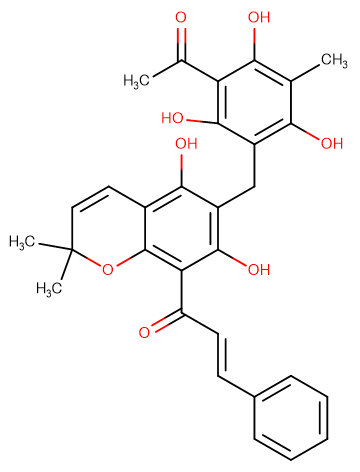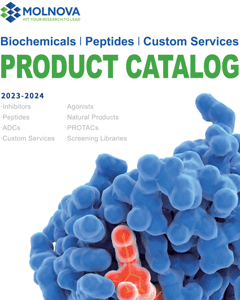
Rottlerin
CAS No. 82-08-6
Rottlerin( Mallotoxin | NSC 94525 )
Catalog No. M16052 CAS No. 82-08-6
Rottlerin (Mallotoxin;NSC 94525) is a polyphenol natural product, cell-permeable and reversible PKC inhibitor that exhibits greater selectivity for PKCδ (IC50=3-6 uM) and PKCθ.
Purity : >98% (HPLC)
 COA
COA
 Datasheet
Datasheet
 HNMR
HNMR
 HPLC
HPLC
 MSDS
MSDS
 Handing Instructions
Handing Instructions
| Size | Price / USD | Stock | Quantity |
| 5MG | 32 | In Stock |


|
| 10MG | 50 | In Stock |


|
| 25MG | 106 | In Stock |


|
| 100MG | Get Quote | In Stock |


|
| 200MG | Get Quote | In Stock |


|
| 500MG | Get Quote | In Stock |


|
| 1G | Get Quote | In Stock |


|
Biological Information
-
Product NameRottlerin
-
NoteResearch use only, not for human use.
-
Brief DescriptionRottlerin (Mallotoxin;NSC 94525) is a polyphenol natural product, cell-permeable and reversible PKC inhibitor that exhibits greater selectivity for PKCδ (IC50=3-6 uM) and PKCθ.
-
DescriptionRottlerin (Mallotoxin;NSC 94525) is a polyphenol natural product, cell-permeable and reversible PKC inhibitor that exhibits greater selectivity for PKCδ (IC50=3-6 uM) and PKCθ, with significantly reduced potency (IC50=30-42 uM) for PKCα, PKCβ, and PKCγ; also inhibits CaMK III, suppresses eEF-2 phosphorylation with IC50 of 5.3 uM; also remarkably inhibits MACC1 promoter activity and expression, reduces cell motility in CRC cells.
-
In VitroRottlerin (20 μM, 2/6/24 hours) dramatically decreases the cyclin D-1 mRNA levels in a time-dependent manner in primary HMVEC.Rottlerin (20 μM) exhibits cell proliferation in HMVEC. Western Blot Analysis Cell Line:Primary HMVEC (Human Microvascular Endothelial Cell).Concentration:20 μM.Incubation Time:2, 6, 24 hours.Result:Dramatically decreased the cyclin D-1 mRNA levels in a time-dependent manner. After 2 h of treatment, the mRNA level was reduced to 50% of the control, to circa 40% after 6 h, and to 20% after 24 h. Consistently, a similar trend was observed in the protein levels, where the decrease was circa 50% after 2 h, 80% after 6 h, and to almost undetectable levels after 24 h.Cell Proliferation Assay Cell Line:Primary HMVEC (Human Microvascular Endothelial Cell).Concentration:20 μM.Incubation Time:24/48 hours.Result:Exhibited a strong growth inhibition, with a reduction in thymidine incorporation respect to the control cells (DMSO 0.1%) of circa 75% and 80%, respectively.
-
In VivoRottlerin (20 mg/kg, gavage 5 days per week, once daily, for 6 weeks) inhibits AsPC-1 pancreatic tumor growth in Balb C nude mice with no toxicity.Rottlerin inhibits tumor cell proliferation, and induces apoptosis through activation of caspase-3 and cleavage of poly(ADP-ribose) polymerase (PARP). Animal Model:Balb C nude mice (4-6 weeks old) with AsPC-1 cells (2×106 cells mixed with Matrigel, 50:50 ratio) injection.Dosage:0 or 20 mg/kg.Administration:Gavage 5 days per week, once daily, for 6 weeks.Result:Inhibited AsPC-1 pancreatic tumor growth in Balb C nude mice and had no effect
-
SynonymsMallotoxin | NSC 94525
-
PathwayAngiogenesis
-
TargetPKC
-
RecptorPKC
-
Research AreaOther Indications
-
Indication——
Chemical Information
-
CAS Number82-08-6
-
Formula Weight516.54
-
Molecular FormulaC30H28O8
-
Purity>98% (HPLC)
-
SolubilityDMSO : 2 mg/mL 3.87 mM;H2O : < 0.1 mg/mL
-
SMILESCC1(C)C=CC2=C(O)C(CC3=C(C(C)=C(C(C(C)=O)=C3O)O)O)=C(O)C(C(/C=C/C4=CC=CC=C4)=O)=C2O1
-
Chemical Name(2E)-1-[6-[(3-acetyl-2,4,6-trihydroxy-5-methylphenyl)methyl]-5,7-dihydroxy-2,2-dimethyl-2H-1-benzopyran-8-yl]-3-phenyl-2-propen-1-one
Shipping & Storage Information
-
Storage(-20℃)
-
ShippingWith Ice Pack
-
Stability≥ 2 years
Reference
1. Villalba M, et al. J Immunol. 1999 Dec 1;163(11):5813-9.
2. Gschwendt M, et al. FEBS Lett. 1994 Jan 24;338(1):85-8.
3. Juneja M, et al. PLoS Biol. 2017 Jun 1;15(6):e2000784.
molnova catalog



related products
-
PKC-iota inhibitor 1
PKC-iota inhibitor 1 is an inhibitor of protein kinase C-iota (PKC-ι ; IC50 : 0.34 μM).
-
6,7,4'-Trihydroxyiso...
6,7,4'-Trihydroxyisoflavone, is a novel inhibitor of PKCα in suppressing solar UV-induced matrix metalloproteinase 1, which has antioxidant, and anti-cancer activities.Molecular studies showed that 6,7,4'-THIF significantly inhibited acetylcholinesterase and thiobarbituric acid reactive substance (TBARS) activities in the hippocampus of scopolamine-induced mice.
-
Rottlerin
Rottlerin (Mallotoxin;NSC 94525) is a polyphenol natural product, cell-permeable and reversible PKC inhibitor that exhibits greater selectivity for PKCδ (IC50=3-6 uM) and PKCθ.



 Cart
Cart
 sales@molnova.com
sales@molnova.com


